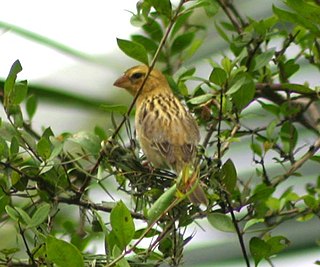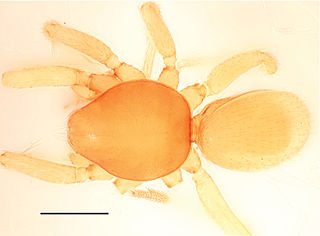
Insects in the family Tettigoniidae are commonly called katydids, or bush crickets. They have previously been known as "long-horned grasshoppers". More than 6,400 species are known. Part of the suborder Ensifera, the Tettigoniidae are the only extant (living) family in the superfamily Tettigonioidea.

The Eurasian eagle-owl is a species of eagle-owl that resides in much of Eurasia. It is also called the Uhu and in Europe, it is occasionally abbreviated to just the eagle-owl. It is one of the largest species of owl, and females can grow to a total length of 75 cm (30 in), with a wingspan of 188 cm, with males being slightly smaller. This bird has distinctive ear tufts, with upper parts that are mottled with darker blackish colouring and tawny. The wings and tail are barred. The underparts are a variably hued buff, streaked with darker colouring. The facial disc is not very visible and the orange eyes are distinctive.

The Eurasian golden oriole or simply golden oriole, is the only member of the Old World oriole family of passerine birds breeding in Northern Hemisphere temperate regions. It is a summer migrant in Europe and western Asia and spends the winter season in central and southern Africa.

Wolf spiders are members of the family Lycosidae, from the Ancient Greek word λύκος, meaning "wolf". They are robust and agile hunters with excellent eyesight. They live mostly in solitude, hunt alone, and do not spin webs. Some are opportunistic hunters, pouncing upon prey as they find it or chasing it over short distances; others wait for passing prey in or near the mouth of a burrow.

Nursery web spiders (Pisauridae) is a family of araneomorph spiders first described by Eugène Simon in 1890. They resemble wolf spiders (Lycosidae) except for several key differences. Wolf spiders have two very prominent eyes in addition to the other six, while a nursery web spider's eyes are all about the same size. Additionally, female nursery web spiders carry their egg sacs with their jaws and pedipalps instead of attaching them to their spinnerets as wolf spiders do. When the eggs are about to hatch, a female spider builds a nursery "tent", places her egg sac inside, and stands guard outside, hence the family's common name. Like the wolf spiders, however, the nursery web spiders are roaming hunters that don't use webs for catching prey.

Atypidae, also known as atypical tarantulas or purseweb spiders, is a spider family containing only three genera. They are accomplished ambush predators that spend most of their time in a sock-like, silken retreat on the ground from where they kill their prey.

The white-rumped shama is a small passerine bird of the family Muscicapidae. Native to densely vegetated habitats in the Indian subcontinent and Southeast Asia, its popularity as a cage-bird and songster has led to it being introduced elsewhere.

The greater horseshoe bat is an insectivorous bat of the genus Rhinolophus. Its distribution covers Europe, Northern Africa, Central Asia and Eastern Asia. It is the largest of the horseshoe bats in Europe and is thus easily distinguished from other species. The species is sedentary, typically travelling up to 30 kilometres (19 mi) between the winter and summer roosts, with the longest recorded movement being 180 km (110 mi). The frequencies used by this bat species for echolocation lie between 69–83 kHz, have most energy at 81 kHz and have an average duration of 37.4 ms.

Danaus chrysippus, also known as the plain tiger, African queen, or African monarch, is a medium-sized butterfly widespread in Asia, Australia and Africa. It belongs to the Danainae subfamily of the brush-footed butterfly family Nymphalidae. Danainae primarily consume plants in the genus Asclepias, more commonly called milkweed. Milkweed contains toxic compounds, cardenolides, which are often consumed and stored by many butterflies. Because of their emetic properties, the plain tiger is unpalatable to most predators. As a result, the species' coloration is widely mimicked by other species of butterflies. The plain tiger inhabits a wide variety of habitats, although it is less likely to thrive in jungle-like conditions and is most often found in drier, wide-open areas.
Juniperus pseudosabina, the Turkestan juniper or dwarf black juniper is a species of juniper.

The Asian golden weaver is a species of bird in the family Ploceidae. It is found in Cambodia, Indonesia, Laos, Myanmar, Thailand, and Vietnam. Its natural habitats are subtropical or tropical seasonally wet or flooded lowland grassland, swamps, and arable land. It is threatened by habitat loss.

Leptotes pirithous, the Lang's short-tailed blue or common zebra blue, is a butterfly of the family Lycaenidae.

Catopsilia florella, the African migrant, African emigrant, or common vagrant, is a butterfly of the family Pieridae. It is found in Africa and the Canary Islands. Like Catopsilia pomona, this species also has a habit of migration.

Bannana is a genus of goblin spiders native to Xishuangbanna prefecture, Yunnan Province, China, where it lives in the leaf-litter of tropical rainforest. There are two known species: Bannana crassispina and B. parvula, both described in 2015. Individuals are pale yellow and unpatterned, and range from around 1.0 to 1.8 mm in body length, with females being slightly larger than males. The eyes are reduced or entirely absent. Known only from a nature reserve in Xishuangbanna, Bannana belongs to a group of Asian goblin spiders known as the "Dysderoides complex", that ranges from China to Pakistan and south to Indonesia.

Leucadendron salignum, also known as the common sunshine conebush, is an evergreen, dioecious shrub that produces several stems from the ground of up to 2 metres high; forming part of the genus Leucadendron from the family Proteaceae. It survives the wildfires that occur every one or two decades in the fynbos where it occurs by regrowing from an underground rootstock. Pollinated by beetles, it flowers from April to November. The winged seeds remain in the woody cones until they are released after a fire, and are distributed by the wind. It is possibly the most common Proteaceae species in South Africa, and can be found in the Northern Cape, Western Cape and Eastern Cape provinces. Its current conservation status is Least Concern.
Habroteleia mutabilis, is a species of wasp belonging to the family Platygastridae. It is described from Fiji.
Habroteleia ruficoxa, is a species of wasp belonging to the family Platygastridae. It is found in Philippines.
Habroteleia salebra, is a species of wasp belonging to the family Platygastridae. It is described from Papua New Guinea and Indonesia.
Habroteleia soa, is a species of wasp belonging to the family Platygastridae. It is the most geographically disjunct member of the genus, which is separated by other members by the Indian Ocean. It is found in Papua New Guinea and Indonesia.
Habroteleia spinosa, is a species of wasp belonging to the family Platygastridae. It is described from Papua New Guinea and Indonesia.














